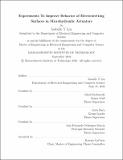Experiments To Improve Behavior of Electrowetting Surfaces in Microhydraulic Actuators
Author(s)
Liu, Isabelle Y.
DownloadThesis PDF (38.88Mb)
Advisor
Kedzierski, Jakub
Racz, Livia
Velásquez-García, Luis Fernando
Terms of use
Metadata
Show full item recordAbstract
Microhydraulic actuators based on the principles of electrowetting were developed at MIT Lincoln Laboratory. The actuators consist of two parts, rotor (droplet array) and stator (electrode array), that move relative to each other. This thesis focuses on the latest two versions of actuators, MHA5 and MHA6, which differ in geometry and fabrication process. MHA5 demonstrated successful electrical actuation but had stability issues; the initial version of MHA6 (MHA6A) couldn’t actuate due to high friction between the rotor and stator surface. This thesis investigated possible causes of high friction in MHA6 through quantitative friction drag experiments and contact angle experiments, and determined fabrication processes that led to low friction surfaces. The findings were incorporated to make a subsequent version of MHA6 (MHA6B) which demonstrated successful electrical actuation. This thesis also calculated the actuators’ expected torque, and performed the first quantitative torque measurements.
Date issued
2022-09Department
Massachusetts Institute of Technology. Department of Electrical Engineering and Computer SciencePublisher
Massachusetts Institute of Technology